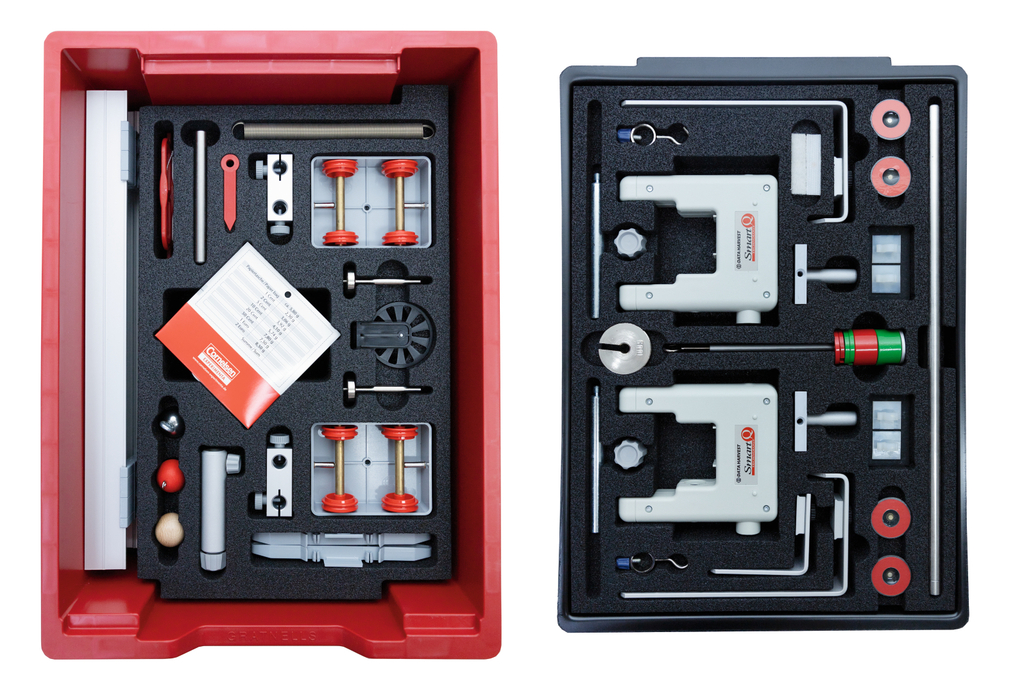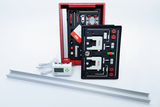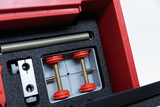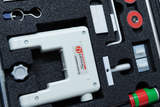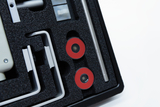Students kit Dynamics 2.0
The kit contains equipment and resources required for investigating the basic laws of motion and oscillation. A digital timer is included to support the efficiency of experimenting.
Pupils can make measurements in a conventional manner irrespective of the power supply, but can also analyse the saved results on a PC later on.
In addition, the timer can be used as an interface, allowing any measurement to be displayed, processed and saved on a PC or notebook computer.
The measurements are recorded by means of accurate and reliable light barriers. The precisely manufactured carriage with its own propulsion is characterised by the extremely high precision of its movement.
This kit covers the following basic laws of physics:
- Newton’s laws
- Galileo’s equivalence principle
- Huygens’ law of collision
- Galileo’s laws of pendulum
- Principle of action and reaction
This experiment investigates a motorised trolley moving in a uniform motion on a straight line. For each of the various distances travelled, the corresponding time to cover the distance will be measured in order to determine the speed or velocity of the trolley.
In the first experiment on Newton’s laws, we will investigate the relationships a ~ 1 / m and a ~ F, which will be combined to form Newton’s second law F = m · a at the end.
This involves measuring the acceleration of the trolley directly for each of the various configurations using a spoked wheel on a light barrier. Newton’s first and third laws are covered in experiment D02.2 “Newton’s laws (2)”.
As a continuation to the previous experiment, you will use the following pair of experiments to discover Newton’s first and third laws.
You will observe the principle of inertia and the phenomenon of “action and reaction” with the help of the trolleys on the short rail.
The relationship between distance and time for uniformly accelerating motion is to be investigated by means of an inclined plane. This will involve measuring the time a trolley takes to cover various distances along the plane by means of two light barriers.
Plots of distance against time, velocity against time and acceleration against time are to be obtained for a uniformly accelerating trolley with the help of a spoked wheel passing through a light barrier. The measured curves are then compared to the theoretical ones and interpreted with the help of a game.
Now a light barrier will be used to investigate the relationship between the speed of descent of the free fall pocket vEnd and the height from which it falls h. Initially the relationship between vEnd and h will be derived using the law of conservation of energy for the sum of the potential energy and kinetic energy, then this will be compared to the actual measurement results and discussed.
The range, height of trajectory and launch speed are to be measured for a wooden ball launched horizontally from the table top to land on the floor. The launch speed will be calculated from the length of time that the photoelectric beam of the light barrier is interrupted. The measurement results will then be investigated using the previously introduced formula for the range and discussed.
The period of oscillation of a string pendulum is to be measured directly with a light barrier.
The results should then be used to determine the acceleration due to gravity.
Damping of a string pendulum is to be measured using a light barrier. This should show how kinetic energy decreases exponentially from the lengthening of the time the beam is broken by the pendulum bob as it repeatedly passes through the barrier.
A spring pendulum and a light barrier will be used to show how the measured periods can be used to determine an unknown mass.
For both elastic and inelastic collisions, the velocities of two measurement trolleys along the profile rail track before and after collision are to be measured. The measurements will then be used to investigate whether energy and momentum are conserved in the two types of collision.
With two light barriers and the free fall pocket you can now investigate how the time it takes a body to fall depends on its mass.
The results are then to be compared with calculated values and discussed. Finally the acceleration due to gravity g is measured directly.
With the help of two light barriers and the free fall card, you will now investigate how the time it takes an object to fall depends on the height from which it falls.
The results will be compared to the previously introduced law for falling objects and discussed. There is also a supplement to the worksheet which covers the systematic error to which this measurement is subject.
An investigation is to be made of how the period of oscillation of a string pendulum depends on the length of the pendulum, the deflection from the rest point and the mass of the pendulum bob. The period of oscillation of the pendulum will be measured directly using the light barrier.
Two light barriers on the track are used to investigate a completely inelastic collision between two trolleys. Conservation of momentum will be demonstrated on the basis of the velocities before and after the collisions.
- 1 × String on spool
- 1 × Stand rod 100x10 mmØ stainless steel
- 1 × Rings with hook, set of 5
- 2 × Bosshead with slit
- 1 × Rail, 1000 mm
- 1 × Rail, 360 mm with centre-bore
- 2 × Clamp slider
- 1 × Mass hanger, 10 g
- 2 × Slotted mass, 10 g, red
- 2 × Slotted mass, 10 g, green
- 1 × Slotted mass, 50 g, red
- 1 × Slotted mass, 100 g
- 1 × Slotted mass, 50 g, green
- 1 × Spring 150 mm / 10 N
- 1 × Spring 100 mm / 12 N
- 1 × Drop test card with bag, 100x100 mm
- 2 × Light gate holder
- 1 × Interrupt card, 100mm
- 2 × Interrupt card, 30mm
- 1 × Pointer
- 1 × Light gate holder, short
- 2 × Buffer on rod
- 1 × Pair of buffer plates with velcro strips
- 2 × Carriage with weight and threaded rod
- 1 × Pendulum ball,steel 25mmØ
- 1 × Pendulum ball, wood,25mmØ
- 1 × Wooden ball 25 mm Ø
- 1 × Carton for SEG (large tray)
- 4 × Magnet disc on plug
- 1 × CorEx Logger V4
- 1 × Spocked Pulley
- 2 × Light Gate with support rod
- 1 × Storing tray, deep, red
- 1 × Lid for 75028 + 75038
- 1 × Tray insert 35 mm
- 1 × Clamp pipe
- 1 ×
- 2 ×
- 1 ×
- 1 ×
- 1 ×
- 1 ×
- 2 ×
